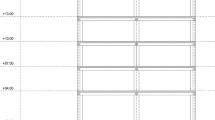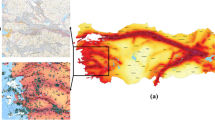Abstract
Vulnerability assessment of gravity dams against destructive phenomena such as earthquakes is important. Vulnerability assessment and prediction of dam’s damage due to earthquakes with variety of intensities can provide helpful information that would be very useful and effective in the proper management of probable crises. One of the useful tools in assessing earthquake damage of concrete dams is the production of their fragility curves. Due to the vulnerability of concrete dams to tensile cracking, a new concept of damage index according to tensile cracking has been developed. Because of dependency of fragility curves to limit states of engineering demand parameters, limit states have been defined according to tensile cracking in dams. Studies on the production of fragility curves of concrete gravity dams are very limited and mostly not comprehensive in a way fragility curve are normally produced only for one type of dam or with one height and one configuration. In this paper, fragility curves have been generated for three gravity dams with different base width (L) and height (H), i.e. Pine Flat dam (United States), Koyna dam (India) and Shafarood dam (Iran). It was shown that Shafarood dam with (L/H) ratio equals to one has better performances under seismic excitation than Pine Flat and Koyna dams that their (L/H) ratios are 0.8, 0.7, respectively.








Similar content being viewed by others
References
Akpinar U, Binici B, Arici Y (2014) Earthquake stresses and effective damping in concrete gravity dams. Earthq Struct 6(3):251–266
Alembagheri M, Ghaemian M (2013a) Seismic assessment of concrete gravity dams using capacity estimation and damage indexes. Earthq Eng Struct Dyn 42(1):123–144
Alembagheri M, Ghaemian M (2013b) Damage assessment of a concrete arch dam through nonlinear incremental dynamic analysis. Soil Dyn Earthq Eng 44:127–137
Ansari MI, Agarwal P (2016) Categorization of damage index of concrete gravity dam for the health monitoring after earthquake. J Earthq Eng 20(8):1222–1238
Arabshahi H, Lotfi V (2008) Earthquake response of concrete gravity dams including dam–foundation interface nonlinearities. Eng Struct 30(11):3065–3073
Baker JW (2015) Efficient analytical fragility function fitting using dynamic structural analysis. Earthq Spectra 31(1):579–599
Bazzurro P, Cornell CA, Menun C, Luco N, Motahari M (2004) Advanced seismic assessment guidelines. Report for Pacific gas and electric-PEER lifelines program, task
Calayir Y, Dumanoğlu AA, Bayraktar A (1996) Earthquake analysis of gravity dam–reservoir systems using the Eulerian and Lagrangian approaches. Comput Struct 59:877–890
Calvi GM, Kingsley GR (1995) Displacement-based seismic design of multi-degree-of-freedom bridge structures. Earthq Eng Struct Dyn 24(9):1247–1266
Dimova SL, Hirata K (2000) Simplified seismic fragility analysis of structures with two types of friction devices. Earthq Eng Struct Dyn 29(8):1153–1175
Elenas A, Meskouris K (2001) Correlation study between seismic acceleration parameters and damage indices of structures. Eng Struct 23(6):698–704
FEMA (2003) NEHRP recommended provisions for seismic regulations for new buildings and other structures (FEMA 450). National earthquake hazards reduction program, part 1: PROVISIONS. Prepared by the Building Seismic Safety Council for the Federal Emergency Management Agency, Washington, DC, USA
Fenves G, Chopra AK (1984) Earthquake analysis of concrete gravity dams including reservoir bottom absorption and dam–water–foundation rock interaction. Earthq Eng Struct Dyn 12(5):663–680
Ganji HT, Alembagheri M, Khaneghahi MH (2019) Evaluation of seismic reliability of gravity dam–reservoir in homogeneous foundation coupled system. Front Struct Civ Eng 13(3):701–715
Gavabar SG, Alembagheri M (2018) Structural demand hazard analysis of jointed gravity dam in view of earthquake uncertainty. KSCE J Civ Eng 22(10):3972–3979
Ghanaat Y, Patev R, Chudgar A (2015) Seismic fragility for risk assessment of concrete gravity dams. In: Proceeding of the USSD annual conference, pp 645–660
Ghobarah A, Abou-Elfath H, Biddah A (1999) Response-based damage assessment of structures. Earthq Eng Struct Dyn 28(1):79–104
Hariri MA, Saouma VE (2016) Probabilistic seismic demand model and optimal intensity measure for concrete dams. Struct Saf 59:67–85
Hariri-Ardebili MA, Saouma VE (2016) Collapse fragility curves for concrete dams: comprehensive study. J Struct Eng 142(10):04016075
Inaudi JA, Matheu EE, Poeppelman RL, Matusevich A (2005) Foundation flexibility effects on the seismic response of concrete gravity dams. In: 37th joint meeting UJNR panel on wind and seismic effects. Tsukuba, Japan, pp 16–20
International Commission on Large Dams (2016) Selecting seismic parameters for large dams—guidelines. ICOLD bulletin 148.
Karim KR, Yamazaki F (2003) A simplified method of constructing fragility curves for highway bridges. Earthq Eng Struct Dyn 32(10):1603–1626
Khosravi S, Heydari MM (2014) Design and modal analysis of gravity dams by ANSYS parametric design language. Walailak J Sci Technol (WJST) 12(2):167–180
Lee J, Fenves GL (1998) A plastic-damage concrete model for earthquake analysis of dams. Earthq Eng Struct Dyn 27:937–956
Lotfi V, Samii A (2012) Dynamic analysis of concrete gravity dam–reservoir systems by wavenumber approach in the frequency domain. Earthq Struct 3(3–4):533–548
Lupoi A, Callari C (2011) The role of probabilistic methods in evaluating the seismic risk of concrete dams. In: Dolšek M (ed) Protection of built environment against earthquakes. Springer, Dordrecht, pp 309–329
Mohammadnezhad H, Ghaemian M, Noorzad A (2019) Seismic analysis of dam–foundation–reservoir system including the effects of foundation mass and radiation damping. Earthq Eng Eng Vib 18(1):203–218
Mridha S, Maity D (2014) Experimental investigation on nonlinear dynamic response of concrete gravity dam–reservoir system. Eng Struct 80:289–297
Park YJ, Ang AH (1985) Mechanistic seismic damage model for reinforced concrete. J Struct Eng 111(4):722–739
PEER (Pacific Earthquake Engineering Research Center) (2014) Ground motion database. CA
Porter KA, Kiremidjian AS (2000) Assembly-based vulnerability of buildings and its uses in seismic performance evaluation and risk-management decision-making. SPA Risk LLC, Denver
Sevim B (2018) Geometrical dimensions effects on the seismic response of concrete gravity dams. Adv Concr Constr 6(3):269–283
Shinozuka M, Feng MQ, Lee J, Naganuma T (2000) Statistical analysis of fragility curves. J Eng Mech 126(12):1224–1231
Shinozuka M, Feng MQ, Kim HK, Kim SH (2000) Nonlinear static procedure for fragility curve development. J Eng Mech 126(12):1287–1295
Smyth AW, Deodatis G, Franco G, He Y, Gurvich T (2004) Evaluating earthquake retrofitting measures for schools: a cost-benefit analysis. In: Rodrigue C, Rovai E (eds) School safety and security: keeping schools safe in earthquakes, vol 4. Routledge, London, pp 208–216
Sotoudeh P, Ghaemian M, Mohammadnezhad H (2019) Seismic analysis of reservoir-gravity dam-massed layered foundation system due to vertically propagating earthquake. Soil Dyn Earthq Eng 116:174–184
Tekie PB, Ellingwood BR (2003) Seismic fragility assessment of concrete gravity dams. Earthq Eng Struct Dyn 32(14):2221–2240
Vamvatsikos D, Cornell CA (2002) Incremental dynamic analysis. Earthq Eng Struct Dyn 31(3):491–514
Vamvatsikos D, Cornell CA (2004) Applied incremental dynamic analysis. Earthq Spectra 20(2):523–553
Vamvatsikos D, Fragiadakis M (2010) Incremental dynamic analysis for estimating seismic performance sensitivity and uncertainty. Earthq Eng Struct Dyn 39(2):141–163
Yazdani Y, Alembagheri M (2017a) Seismic vulnerability of gravity dams in near-fault areas. Soil Dyn Earthq Eng 102:15–24
Yazdani Y, Alembagheri M (2017b) Nonlinear seismic response of a gravity dam under near-fault ground motions and equivalent pulses. Soil Dyn Earthq Eng 92:621–632
Zhang S, Wang G, Sa W (2013) Damage evaluation of concrete gravity dams under mainshock–aftershock seismic sequences. Soil Dyn Earthq Eng 50:16–27
Author information
Authors and Affiliations
Corresponding author
Additional information
Publisher's Note
Springer Nature remains neutral with regard to jurisdictional claims in published maps and institutional affiliations.
Rights and permissions
About this article
Cite this article
Gavabar, S.G., Alembagheri, M. A Study on Seismic Performance and Fragility of Gravity Dams with Various Monolith Shapes Using Nonlinear IDA. Geotech Geol Eng 38, 1133–1150 (2020). https://doi.org/10.1007/s10706-019-01077-8
Received:
Accepted:
Published:
Issue Date:
DOI: https://doi.org/10.1007/s10706-019-01077-8




